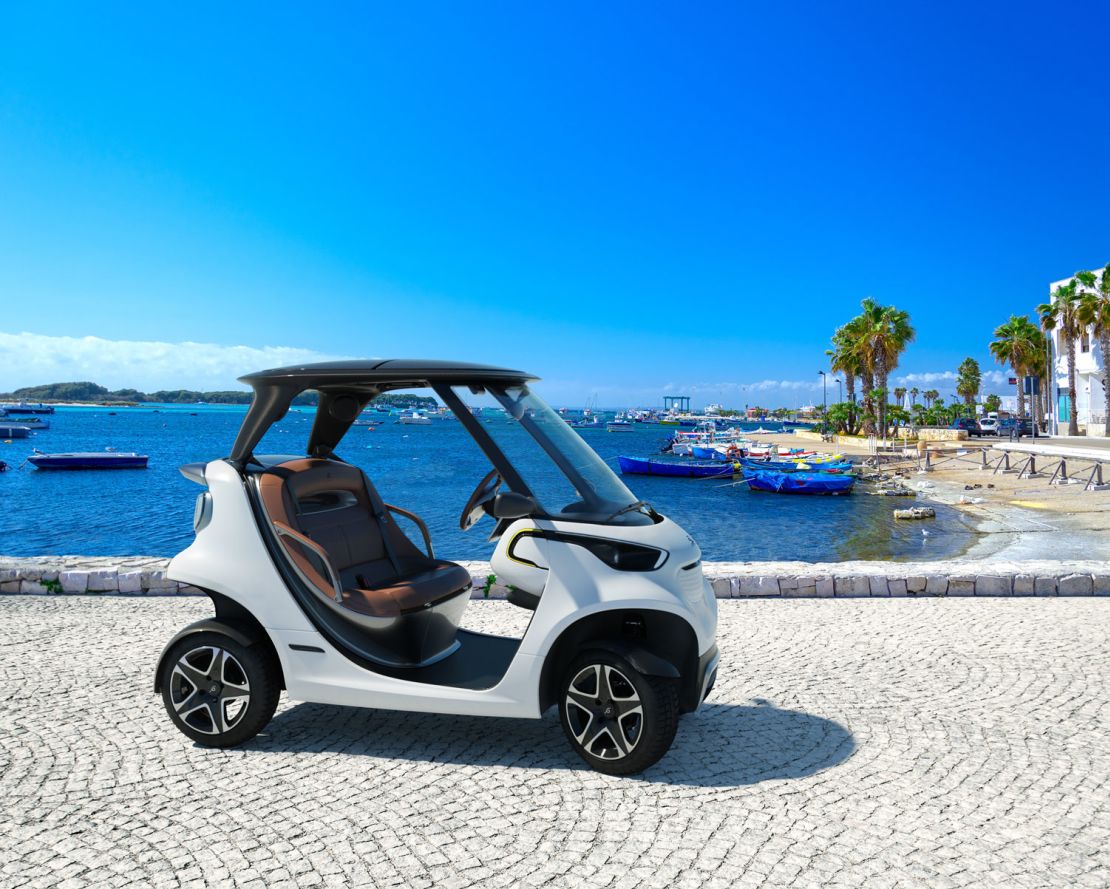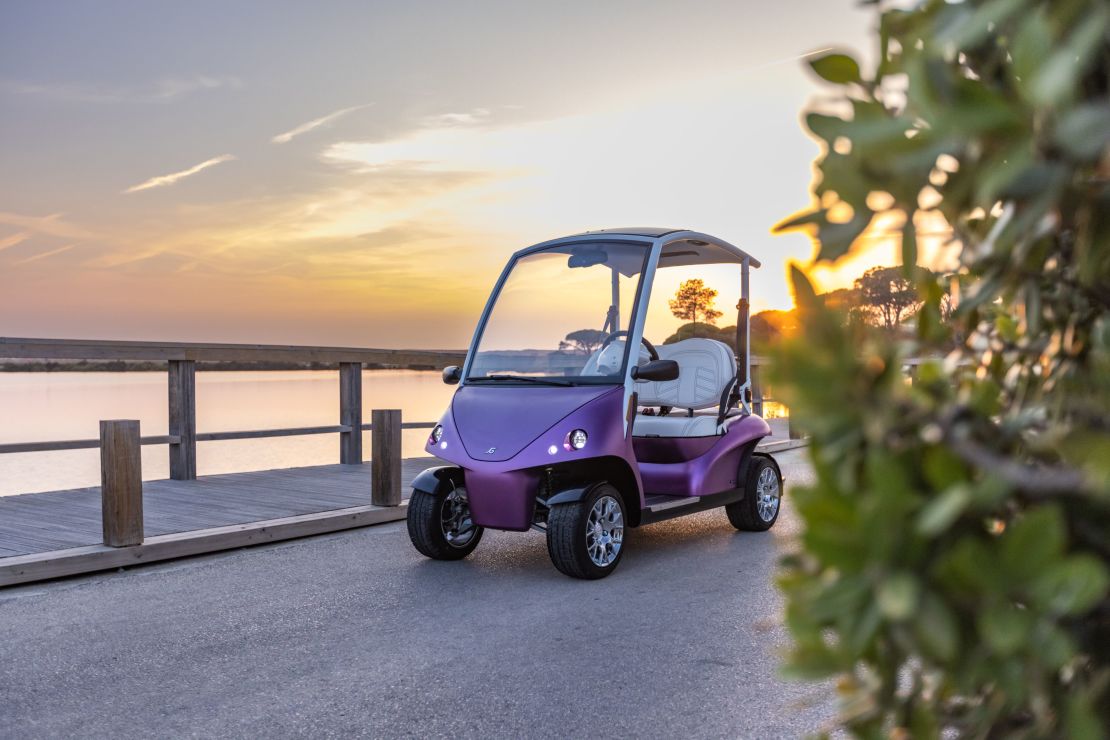CNN
—
From the blooming azaleas of Augusta National to the breathtaking lighthouse at Turnberry in Scotland, golf is renowned for its natural beauty. The same cannot be said, however, for the sport’s primary mode of transport.
But one Danish company is on a mission to put the art in golf cart.
Copenhagen-based Garia is the self-described “world’s first and only” luxury golf and leisure car brand (that’s car, not cart), whose aims to regenerate the traditional golf buggy have led to ambitions that lie far beyond the confines of the 18-hole course.
Such goals seemed a long drive away in 2005 when Anders Lynge, still in design school, met Soren Bak Hansen during an internship at a car company. A short while later, having spotted a gap in the market, the duo founded Garia.
“When it came to the golf cart 18 years ago, they all looked the same – there weren’t any serious high-end products out there,” Lynge told CNN.
“If you lived in a high-end community – paying hundreds of thousands of dollars of membership fees, a $10 million house, whatever you had – the whole lifestyle of these people, from their cars to their clothes, watches; everything was super personalized.
“We thought it was strange that they all had the same type of golf cart … So the idea behind Garia was basically to say, ‘How can we make a product that fulfils the lifestyle of these people, that has the same sort of quality that they’re used to from every other product they surround themselves with?’
“That really changed our focus to say, ‘Hey, let’s do that: the ultimate golf car.’”

Reinventing the wheel(s)
Achieving that aim was easier said than done when the team was effectively tasked with reinventing the wheel and – as Lynge remarked – an unattractive one at that.
There are several reasons for the uniformity of the traditional golf buggy, narrow and vertical in shape, Lynge explained. The universal requirement of having to fit onto golf courses and their various cart paths – needing to perform 180-degree turns in a cul-de-sac – limits design creativity.
“It’s like trying to do a new bicycle or a new motorcycle,” Lynge said. “You’re so heavily constrained from a technical standpoint.
“It’s the worst kind of shape you can have – it doesn’t look very dynamic. You want something that’s sort of Lamborghini-shaped – very low and wide – but the golf cart is the exact opposite.”

Yet solutions emerged: extending the wheelbase, enlarging the cabin, unprecedented 12-inch alloy wheels without hubcaps that replaced the traditional “deep dish” look, and a double wishbone front suspension – common in sports cars – to boost handling.
Garia’s vehicles may look bigger and more “muscular” than the average golf cart, but the proportions are the same as any other standard buggy. This is simply a visual “trick” – and far from the only one.
A storage box tucked behind the seat serves to lift the beltline, slashing cabin space to give it more of a car feel, while accent lines and wheels pushed out to the edges help ground the vehicle.
Lynge toyed extensively with positive and negative space, taking inspiration from Porsche’s 911 to use convex and concave shapes across the car. It makes warehouse storage a “nightmare,” but the visual payoffs are worth the trouble, Lynge says.

Elite company
In fact, it is rare that any two Garias look exactly the same.
Using an online configurator inspired by Nike’s shoe customizer, prospective buyers can hand-pick almost every aspect of their vehicle; from body and roof color – 44 options and rising – to wheels and interior features like refrigerators and cup holders. There are millions of possible combinations, Lynge insists.
German luxury car modification firm Mansory, which works with clients including Bentley and Lamborghini, provides a range of accessories and even a full carbon-fiber car.
Other collaborations have included German Bugatti supplier Kussmaul, which Garia paired with to build a single, special edition chrome car capable of doing 0 to 40 kilometers per hour (25 miles per hour) in less than two seconds.
Another involved Mercedes, whom Lynge first made contact with after winning a competition run by the car giant to design a golf cart. Lynge took the prize ceremony event as an opportunity to pitch a dream that would be realized in 2016 – a Garia golf car inspired by Mercedes-Benz Style.
Retailing at just under €80,000 ($86,000), the fully carbon-fiber car had twice the battery life and twice the power of a typical Garia, topping out at speeds of 69 kilometers per hour (43 miles per hour).
“Really expensive … super exclusive, but also the coolest golf car you’ll ever see,” Lynge said.

Out of bounds
Its scarcity means only a select few will have been seen on European roads.
Making street legal models was always the plan for Garia, but achieving certification is no easy feat. Extensive – and therefore expensive – safety and crash testing is required to gain road-status, and requirements differ across regions.
While Europe allows for greater speeds, the US employs a strict 40 kilometers per hour (25 miles per hour) legal limit on such vehicles. But that did not discourage Lynge, who saw the prevalence of golf communities in the US as a potentially lucrative market for Garia. The company was sold by the Lars Larsen Group to American golf and utility giant Club Car in 2022.
The base version of Garia’s two-seater golf car – without any customization or additional features – has a manufacturer suggested retail price of €14,939 ($16,100), with the four-seater edition starting from €20,189 ($21,770). The street legal variants for both Europe and the US come in at €18,959 ($20,440) for the two-seat model and rise to €21,219 ($22,880) for four seats.

“We very much felt that these cars are so fun to drive and they are fun to interact with,” Lynge said. “I don’t know the exact percentage, but a great part of our cars are also bought by people who don’t play golf. They are just in a holiday house.”
As he looks to the future, Lynges envisions Garia branching out of golf and into the leisure space, becoming “more-and-more car-like” with each passing year, making vehicles suited to urban mobility.
“If you drive around London, how fast do you even need to go? Forty-three miles per hour is plenty of opportunity, right? There is some weird sort of space there as the market changes into full electric where everything is sort of up in the air,” he said.
“I don’t know where we’re going to land, but I feel like we have some interesting lessons with us in this journey we’ve been on that puts us in a good position to do mobility, maybe in a wider sense, than just golf.”






